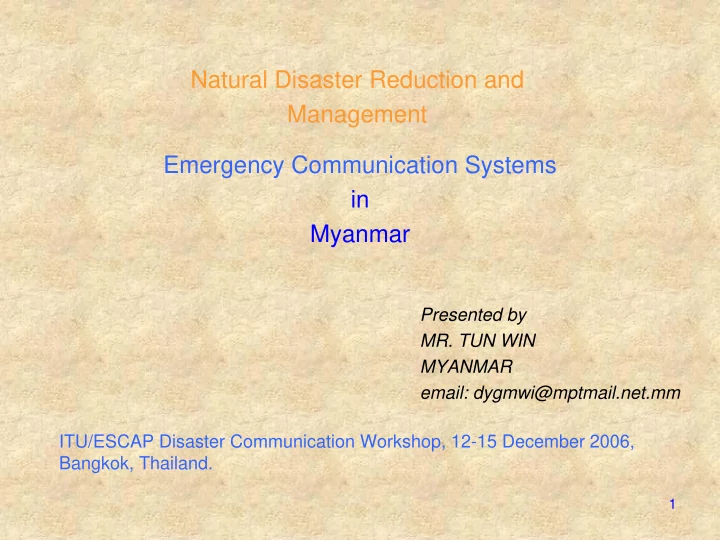

Natural Disaster Reduction and Management Emergency Communication Systems in Myanmar Presented by MR. TUN WIN MYANMAR email: dygmwi@mptmail.net.mm ITU/ESCAP Disaster Communication Workshop, 12-15 December 2006, Bangkok, Thailand. 1
Introduction Myanmar has a long coastline of about 2,400 km long, which covers almost all East coast of Bay of Bengal. According to the Tsunami Risk Atlas, most of the coastal areas of Myanmar are within the risk zone. However, the historical record reveals that the deadliest Intense Tsunamis are rare in Myanmar and her neighboring bay of Bengal Area. During the 26th December 2004 Tsunamis, Tsunamis moved strongly towards the east and west but weakly to the north. Coastal areas in Myanmar are not situated perpendicular to direction of waves but parallel. Hundreds of uninhabited islands in Myeik Archipelago soften impact of tsunamis. 2
Natural Disasters in Myanmar 1. Cyclones 2. Floods 3. Earthquakes 4. Fire � Tsunami Disaster - the first experience in 2004. � The severest natural disaster in Myanmar is the earthquake. 3
Historical Tsunamis in Myanmar There were eight incidents of maritime earthquakes in the Indian Ocean in record. The years were 1524, 1762, 1819, 1847, 1881, 1941, 1945 and 1977. Due to lack of good records on Tsunami events and tolls of death in the Indian Ocean, no Tsunami Early Warning System was established till the deadliest Tsunami of the history occurred in December, 2004. 4
The Indian Ocean Tsunami of 2004 Myanmar Experiences Areas of concern - Taninthayi Coast, Ayeyarwady Delta, Rakhine Coast Impact of the disaster - Death toll of 80-90 - Directly affected population 5-7000 - Longer-term affected population 10-15,000 - Houses, Schools, buildings damaged - Boats & equipment lost or destroyed - Water sources damaged or contaminated - Roads, bridges& communications weakened 5 - Crops & fishponds inundated.
The Indian Ocean Tsunami of 2004 Myanmar Experiences (Cont.) � The arrival time of Tsunami wave towards Myanmar was about 3 hours. � The epicenter is at a distance of about 1,000 km away. � The average speed of approaching tsunami waves towards Myanmar Coast is 330 km/hr. � The calculated speed of propagation towards the coast is 160 km/hr. � There was a minimal damage in Myanmar due to the 2004 Indian Ocean tsunami comparing to our neighboring countries. 6
Causes of minimal damage � existence of Seismic Gap � direction of the waves � topographic feature of seabed level � unspoiled mangrove forests � existence of hundreds of uninhabited islands in Myeik Archipelago 7
Lost and Damage in Myanmar by Tsunami 26th December, 2004 Death - 61 Injured - 42 Houses destroyed - 601 Villages - 29 Homeless - 2,592 Total losses - Ks. 1,585.56 million 8
Existing Means of Warning Dissemination Radio to general public Television Telephone to local authority Fax / e-mail ( Dissemination by radio is effective only when service is available ) 9
The Role of News and Periodicals Enterprise in Disaster Communication (1) Providing educative information through media during normal times. (2) Releasing relevant news at normal times. i.e. weather forecasts. (3) Sending information immediately to all respective groups via Myanmar News Agency during the time of emergency. (4) Communicating with the affected area during the time of disaster and releasing news about the latest developments continuously. (5) Making follow-up news statements after the disaster. 10
National Committee on Disaster Prevention and Management (2005, January) � Prime Minister Chairman � Minister Vice-chairman (Social Welfare, Relief and Resettlement) � State / Division Chairman Member � Minister concerned (16 Ministries) Member � Mayor (Yangon and Mandalay) Member � Deputy Minister for Home Affairs Secretary � Deputy Minister for Joint Secretary Social Welfare, Relief and Resettlement 11
Central Committee and 10 Sub-committees Disaster Prevention Management Central Working Committee 1. Sub-committee for Information and Public Education 2. Sub-committee for Establishing Emergency Communication System 3. Sub-committee for Search and Rescue 4. Sub-committee for Emergency Assistance 5. Sub-committee for Assessment of Losses 6. Sub-committee for Transport and Clearing of Ways 7. Sub-committee for Mitigation and Shelter 8. Sub-committee for Health 9. Sub-committee for Rehabilitation and Reconstruction 10. Sub-committee for Security 12
Sub-committee for Establishing Emergency Communication System 1. Minister, Chairman Ministry of Communications, Posts and Telegraphs 2. Deputy Minister, Member Ministry of Home Affairs 3. Deputy Minister, Member Ministry of Transportation 4. Representative, Member Ministry of Defends 5. Director General, Member Department of Metrology and Hydrology 6. Director General, Secretary Posts and Telecommunications Department 7. Managing Director, Joint Secretary 13 Myanma Posts and Telecommunications
The Emergency Communication Systems during Disasters 1. Domestic Satellite Terminal System 2. High Frequency Radio Telephone System 3. MPT Satellite Terminal System 14
15 Thank You. Thank You.
Recommend
More recommend